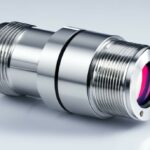Last Updated on 5 months by Francis
Welcome to our exploration of the fascinating world of turtles and infrared technology. In this article, we will delve into the potential for turtles to utilize infrared light and the impact it can have on their care and conservation. Join us as we uncover the exciting possibilities that infrared technology holds for these incredible creatures.
Contents
Key Takeaways
- Turtles have the potential to benefit from the use of infrared light technology.
- Infrared technology, specifically thermal infrared sensors, can assist in detecting and monitoring nesting sea turtles.
- The use of infrared light has practical applications in turtle care, providing supplemental heat and stimulating natural behavior.
- Infrared technology plays a significant role in conservation efforts, protecting nesting turtles and aiding population assessments.
- By implementing infrared technology on a large scale, researchers and conservationists can gather more comprehensive data on nesting sea turtles.
Now, let’s dive deeper into the world of turtles and infrared light to uncover the unique ways in which this technology can benefit these incredible creatures.
The Importance of Turtle Nest Monitoring
Nesting sea turtles are monitored on hundreds of beaches globally to assess population trends and track the recovery of endangered species. Traditional monitoring methods, which rely on human patrollers counting females, nests, and tracks, present limitations and dangers, particularly in remote and dangerous habitats. Infrared technology, such as TIR sensors mounted on drones, offers a potential solution by enhancing surveillance efforts, improving accuracy in population counts, and reducing the risks faced by patrollers.
Infrared technology, specifically thermal infrared sensors, can detect the body heat of warm-blooded animals, including nesting sea turtles. By detecting the thermal differences between the turtles and their surrounding environment, TIR sensors can assist in the detection and monitoring of nesting activity. This technology not only helps in identifying nesting turtles at night but also provides valuable insights into their behavior and health. Infrared light can be used to track basking behavior and understand the impact of temperature variations on turtle nesting.
Studies have shown that using TIR sensors mounted on drones for sea turtle monitoring can provide more accurate population counts compared to traditional observer methods. In some cases, TIR drones have detected significantly more turtles than manual counts during mass nesting events. Additionally, the use of infrared technology reduces the need for labor-intensive human patrollers, making monitoring more efficient and cost-effective. Setting up infrared light sources for turtles involves installing TIR sensors on drones and optimizing camera settings to ensure effective detection and monitoring.
| Traditional Monitoring Methods | Infrared Technology | |
|---|---|---|
| Accuracy | May have limitations | Improved accuracy in population counts |
| Efficiency | Labor-intensive | Reduces the need for human patrollers |
| Detection | Rely on visual cues | Detects thermal differences for improved monitoring |
| Risks | Dangers for human patrollers | Reduces risks faced by patrollers |
While infrared technology shows promise for sea turtle monitoring, there are challenges that need to be addressed. One major limitation is that most RGB drones can only be used during the day, while turtle nesting activity primarily occurs at night. The use of TIR sensors on drones for nighttime monitoring is still relatively new, and further research is needed to assess their efficacy in different settings and to differentiate between species tracks. Additionally, the use of infrared light in turtle tanks requires careful consideration of temperature control and potential impacts on the turtles’ behavior and health.
Turtle Basking with Infrared Light: Enhancing Health and Behavior

Infrared technology, specifically thermal infrared sensors, offers a unique way to support the health and well-being of turtles. By providing supplemental heat and creating basking spots, infrared light can mimic the warmth of the sun and stimulate natural behavior in captive environments. This has significant implications for turtle care and can contribute to their overall health and happiness.
When turtles bask, they expose themselves to heat sources to regulate their body temperature and activate essential biological processes. Infrared heat lamps can effectively provide the necessary warmth for turtles to maintain proper body temperature, enabling digestion, metabolism, and overall physiological functions. The gentle heat emitted by infrared light is similar to the natural sunlight turtles would receive in their natural habitats, promoting their well-being in captivity.
In addition to heat regulation, infrared light exposure also plays a crucial role in Vitamin D synthesis. Turtles require UVB radiation for their bodies to convert precursor molecules into active Vitamin D, which is essential for calcium absorption and bone health. By providing access to infrared light, turtles receive the necessary UVB radiation, supporting their overall skeletal development and reducing the risk of metabolic bone diseases.
Overall, the use of infrared light for turtle basking is a valuable tool in promoting their physical and mental well-being. By replicating natural sunlight and providing the necessary heat and UVB radiation, turtles can thrive in captivity, leading to healthier, more active, and happier lives. Further research and advancements in infrared technology will continue to enhance turtle care practices, ensuring the long-term conservation and welfare of these remarkable creatures.
Turtle Care with Infrared Light: Setting Up for Success

When it comes to caring for turtles, incorporating infrared light technology can provide significant benefits. Infrared light can serve as a supplemental heat source, creating basking spots that mimic the warmth of the sun. This is essential for maintaining the proper body temperature of turtles and enabling vital processes such as digestion and metabolism. By setting up infrared light sources in turtle enclosures, caretakers can ensure optimal conditions for their well-being.
Implementing infrared light for turtle care is a straightforward process. First, it’s crucial to select the appropriate infrared heat lamp that emits the right amount of heat for the specific species of turtle. Caretakers should refer to expert guidance or consult with a veterinarian to determine the suitable temperature range. The next step involves positioning the infrared light source in the enclosure to create a designated basking area. This spot should be easily accessible to the turtles and provide ample space for them to bask comfortably.
Proper temperature control is essential when using infrared light for turtles. Regular monitoring and adjustment of the temperature within the enclosure will help maintain optimal conditions. It’s crucial to strike a balance, ensuring that the basking area is warm enough to meet the turtles’ needs without overheating the entire enclosure. Additionally, it’s important to consider the potential behavioral and health impacts of infrared light on turtles. Caretakers should observe the turtles’ response to the infrared light and make necessary adjustments to create a relaxing and healthy environment.
Incorporating infrared light into turtle care has been shown to stimulate natural basking behavior and provide turtles with the necessary UVB radiation for vitamin D synthesis. This can greatly improve their overall health and well-being in captive environments. By implementing infrared technology, caretakers can create a nurturing and comfortable space for turtles, ensuring they thrive in captivity.
Table: Benefits of Infrared Light for Turtle Care
| Benefits | Description |
|---|---|
| Supplemental Heat Source | Infrared light serves as a supplemental heat source, mimicking the warmth of the sun and providing essential warmth for turtles. |
| Stimulates Natural Behavior | Infrared light stimulates turtles’ natural basking behavior, promoting physical activity and mental stimulation. |
| UVB Radiation for Vitamin D | Infrared light provides turtles with the necessary UVB radiation to synthesize vitamin D, essential for their overall health. |
| Improved Digestion and Metabolism | The warmth provided by infrared light enhances turtles’ digestion and metabolism, facilitating proper nutrient absorption. |
| Enhanced Well-being in Captive Environments | By incorporating infrared light, turtles experience improved overall well-being, leading to better health outcomes in captivity. |
Overcoming Challenges with Infrared Technology

While infrared technology shows promise for sea turtle monitoring, there are challenges that need to be addressed. One major limitation is that most RGB drones can only be used during the day, while turtle nesting activity primarily occurs at night. This hinders the use of traditional drones equipped with red-green-blue (RGB) cameras for nighttime surveillance. However, advancements in technology have led to the development of thermal infrared (TIR) sensors, which can be mounted on drones and used to detect and count nesting turtles at night. This innovative approach allows researchers to overcome the limitations of traditional monitoring methods and gather valuable data for sea turtle research and conservation.
Another challenge with using infrared technology for turtle monitoring is the need for further research to assess its efficacy in different settings and differentiate between species tracks. While TIR sensors can detect the thermal differences between nesting turtles and their surrounding environment, more studies are needed to validate the accuracy and reliability of this technology in various habitats. Additionally, the use of infrared light in turtle tanks requires careful consideration of temperature control and its potential impacts on the behavior and health of captive turtles. Maintaining optimal conditions and ensuring the well-being of the turtles are essential factors to consider when implementing infrared light in turtle care.
“The use of infrared technology for sea turtle monitoring has revolutionized surveillance efforts, providing a more efficient and accurate way to detect and count nesting turtles. However, to fully harness the potential of this technology, we need to address the challenges it presents and conduct further research to optimize its application in different scenarios.”
| Challenges | Solutions |
|---|---|
| Limited drone usage during nighttime | Development of TIR sensors mounted on drones for nocturnal monitoring |
| Validation of efficacy in different settings | Further research and studies to assess the accuracy and reliability |
| Impact on turtle behavior and health in tanks | Proper temperature control and careful monitoring of captive turtles |
Despite these challenges, the benefits of using infrared technology for sea turtle monitoring and conservation cannot be ignored. By overcoming the limitations of traditional methods, infrared technology improves surveillance capabilities, enhances accuracy in population counts, and reduces the risks faced by human patrollers. It also offers practical applications in turtle care, providing supplemental heat and simulating natural behavior in captive environments. With ongoing advancements and research, infrared technology has the potential to play a crucial role in the protection and conservation of endangered sea turtles.
Practical Applications of Infrared Light for Turtle Care

When it comes to turtle care, infrared light has emerged as a valuable tool with a range of practical applications. One of the key benefits of infrared light is its ability to provide supplemental heat to turtles, mimicking the warmth of the sun. This is crucial for maintaining their proper body temperature and enabling essential functions such as digestion and metabolism. Infrared heat lamps can be strategically placed to create basking spots in captivity, stimulating natural behavior and providing turtles with the necessary UVB radiation for vitamin D synthesis.
By utilizing infrared light in turtle care, owners can improve overall turtle health and well-being. The warmth provided by infrared heat lamps helps turtles maintain their body temperature, which is vital for their physiological processes. This includes proper growth, digestion, and overall vitality. Infrared light can also aid in the prevention of certain health issues that may arise due to inadequate temperature regulation.
Furthermore, infrared light can have a positive impact on the behavior of captive turtles. By simulating natural basking conditions, infrared heat lamps encourage turtles to engage in sunning activities. Basking is not only important for thermoregulation but also for mental stimulation and overall enrichment. It allows turtles to express natural behaviors and promotes their overall happiness in captivity.
| Benefits of Infrared Light for Turtle Care | Examples |
|---|---|
| Increased warmth and temperature regulation | Proper digestion and metabolism, prevention of health issues |
| Stimulation of natural basking behavior | Mental stimulation, enrichment, improved well-being |
| UVB radiation for vitamin D synthesis | Essential for calcium absorption and shell health |
Overall, the practical applications of infrared light in turtle care are wide-ranging and beneficial. By providing supplemental heat, promoting natural behavior, and ensuring proper UVB exposure, infrared light helps maintain the health and well-being of turtles in captivity. If you’re a turtle owner or enthusiast, incorporating this technology into your turtle care routine can make a significant difference in the quality of life and overall happiness of these remarkable creatures.
The Role of Infrared Technology in Conservation Efforts

When it comes to the conservation of sea turtles, infrared technology has emerged as a valuable tool. By utilizing thermal infrared (TIR) sensors mounted on drones, researchers and conservationists can enhance surveillance and monitoring capabilities, protecting these endangered creatures and their nesting sites.
The use of infrared technology allows for the detection and deterrence of poaching activities, safeguarding nesting turtles and their eggs. By detecting and counting nesting turtles at night, infrared sensors provide valuable data for population assessments. This information enables conservationists to better understand the status of different species and develop targeted strategies for their protection.
Aside from its applications in conservation, infrared light also plays a crucial role in turtle care. In captivity, infrared heat lamps can provide supplemental heat, mimicking the warmth of the sun. This is vital for maintaining proper body temperature, supporting digestion and metabolism, and ultimately improving overall turtle health and well-being.
The Benefits of Infrared Light for Turtles
One of the key advantages of infrared light for turtle care is its ability to stimulate natural basking behavior. Infrared light can create basking spots in captivity, enabling turtles to receive essential UVB radiation for vitamin D synthesis. This not only promotes physical activity and natural behavior but also contributes to the overall health and vitality of captive turtles.
The Role of Infrared Technology in Protecting Endangered Species
By utilizing infrared technology, conservation organizations can cover large areas and detect thermal signatures, making it an invaluable tool for protecting endangered sea turtles. With its ability to enhance surveillance, improve accuracy in population counts, and reduce risks faced by human patrollers, infrared technology is paving the way for more targeted and effective conservation efforts.
Implementing Infrared Technology for Large-Scale Monitoring
Implementing infrared technology for large-scale monitoring of sea turtles can revolutionize conservation efforts and provide valuable insights into their behavior and population dynamics. By setting up infrared light for turtles and optimizing drone-mounted thermal infrared (TIR) sensors, researchers and conservationists can gather comprehensive data on nesting sea turtles in remote and difficult-to-access habitats. This technology offers numerous benefits and can enhance the accuracy, efficiency, and safety of monitoring programs.
One of the key benefits of using infrared light for turtles is the ability to detect and count nesting turtles at night. Traditional monitoring methods heavily rely on human patrollers, which can be limited in their effectiveness, particularly in remote or dangerous habitats. By deploying TIR sensors on drones, conservation organizations can cover larger areas and monitor sea turtle activities during crucial nighttime nesting periods. This not only improves accuracy in population counts but also reduces the risks faced by human patrollers.
In addition to population monitoring, implementing infrared technology provides valuable data on turtle behavior and health. Infrared light can track basking behavior, providing insights into nesting patterns and habitat preferences. Furthermore, by monitoring thermal differences between turtles and their surroundings, TIR sensors can help assess turtle health and identify potential threats such as disease or stress. This information is crucial for developing targeted conservation strategies and ensuring the well-being of these endangered species.
| Benefits of Implementing Infrared Technology for Large-Scale Monitoring |
|---|
| Improved accuracy in population counts |
| Enhanced safety for human patrollers |
| Data on nesting patterns and habitat preferences |
| Insights into turtle health and potential threats |
| Advanced monitoring capabilities during nighttime nesting periods |
By combining infrared technology with existing monitoring techniques, conservation organizations can take a significant step forward in protecting and conserving sea turtles. With optimized drone-mounted TIR sensors and standardized protocols, large-scale monitoring efforts can be expanded, providing a more comprehensive understanding of nesting populations and enabling conservationists to develop targeted strategies for species recovery. Infrared technology has the potential to transform the way we monitor and protect sea turtles, ensuring their survival for future generations to come.
Conclusion
Infrared technology, specifically thermal infrared sensors mounted on drones, holds promise for sea turtle monitoring and conservation efforts. By detecting and counting nesting turtles at night, infrared technology can enhance surveillance capabilities, improve accuracy in population counts, and reduce the risks faced by human patrollers.
Additionally, infrared light has practical applications in turtle care, providing supplemental heat and stimulating natural behavior in captive environments. With the ability to mimic the warmth of the sun and provide necessary UVB radiation, infrared light contributes to the overall health and well-being of turtles in captivity.
As technology continues to advance, the implementation of infrared technology for large-scale sea turtle monitoring programs can play a crucial role in protecting and conserving these endangered species. By optimizing drone-mounted TIR sensors and establishing standardized protocols, researchers and conservation organizations can gather more comprehensive data on nesting sea turtles, particularly in remote and difficult-to-access areas where traditional monitoring methods are limited.
Overall, infrared technology and its practical applications in turtle care offer immense potential for the monitoring and conservation of sea turtles. By leveraging the capabilities of infrared sensors and embracing advancements in technology, we can work towards safeguarding these remarkable creatures and preserving their natural habitats for future generations.
FAQ
Can turtles use infrared light?
Turtles cannot use infrared light directly, but it can be used in their care to provide supplemental heat and stimulate natural basking behavior in captivity.
What are the benefits of using infrared light for turtles?
Infrared light can mimic the warmth of the sun, maintaining proper body temperature, enabling digestion and metabolism, and providing necessary UVB radiation for vitamin D synthesis, improving overall turtle health and well-being in captivity.
How can infrared light assist in nest detection?
Infrared technology, specifically thermal infrared sensors, can detect the body heat of nesting sea turtles, helping to identify nesting turtles at night and providing valuable insights into their behavior and health.
How does infrared technology compare to traditional monitoring methods?
Infrared technology, such as TIR sensors mounted on drones, offers enhanced surveillance capabilities, improved accuracy in population counts, and reduced risks faced by human patrollers compared to traditional methods.
What challenges need to be addressed with infrared technology?
One major challenge is the limitation of using RGB drones during the day while turtle nesting activity primarily occurs at night. Further research is needed to assess the efficacy and differentiation between species tracks in different settings.
What are the practical applications of infrared light for turtle care?
Infrared light can provide supplemental heat, create basking spots, and stimulate natural behavior in captive environments, improving overall turtle health and well-being.
What role does infrared technology play in conservation efforts?
Infrared technology enhances surveillance and monitoring capabilities, helps detect and deter poaching activities, provides valuable data for population assessments, and enables the development of targeted conservation strategies for sea turtles.
How can infrared technology be implemented for large-scale monitoring?
By optimizing drone-mounted TIR sensors and establishing standardized protocols, conservation organizations can expand their monitoring efforts and gather more comprehensive data on nesting sea turtles in remote and difficult-to-access sites.
What is the potential of infrared technology for sea turtle monitoring and conservation?
Infrared technology, specifically thermal infrared sensors mounted on drones, holds promise for improving sea turtle monitoring and conservation efforts by enhancing surveillance capabilities, improving accuracy in population counts, and reducing risks to human patrollers.









